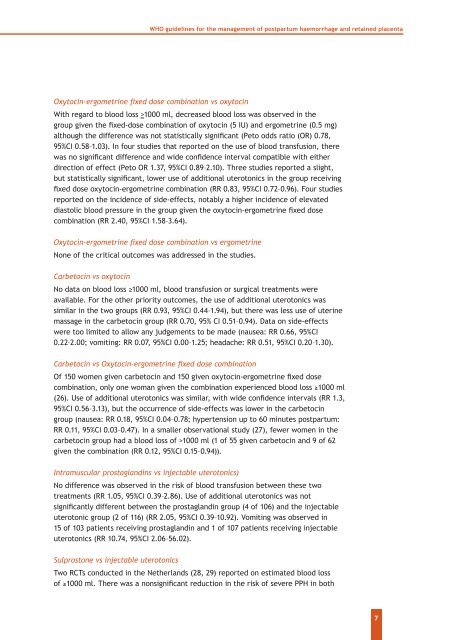WHO guidelines for the management of postpartum haemorrhage ...
WHO guidelines for the management of postpartum haemorrhage ...
WHO guidelines for the management of postpartum haemorrhage ...
You also want an ePaper? Increase the reach of your titles
YUMPU automatically turns print PDFs into web optimized ePapers that Google loves.
<strong>WHO</strong> <strong>guidelines</strong> <strong>for</strong> <strong>the</strong> <strong>management</strong> <strong>of</strong> <strong>postpartum</strong> <strong>haemorrhage</strong> and retained placenta<br />
Oxytocin-ergometrine fixed dose combination vs oxytocin<br />
With regard to blood loss >1000 ml, decreased blood loss was observed in <strong>the</strong><br />
group given <strong>the</strong> fixed-dose combination <strong>of</strong> oxytocin (5 IU) and ergometrine (0.5 mg)<br />
although <strong>the</strong> difference was not statistically significant (Peto odds ratio (OR) 0.78,<br />
95%CI 0.58–1.03). In four studies that reported on <strong>the</strong> use <strong>of</strong> blood transfusion, <strong>the</strong>re<br />
was no significant difference and wide confidence interval compatible with ei<strong>the</strong>r<br />
direction <strong>of</strong> effect (Peto OR 1.37, 95%CI 0.89–2.10). Three studies reported a slight,<br />
but statistically significant, lower use <strong>of</strong> additional uterotonics in <strong>the</strong> group receiving<br />
fixed dose oxytocin-ergometrine combination (RR 0.83, 95%CI 0.72–0.96). Four studies<br />
reported on <strong>the</strong> incidence <strong>of</strong> side-effects, notably a higher incidence <strong>of</strong> elevated<br />
diastolic blood pressure in <strong>the</strong> group given <strong>the</strong> oxytocin-ergometrine fixed dose<br />
combination (RR 2.40, 95%CI 1.58–3.64).<br />
Oxytocin-ergometrine fixed dose combination vs ergometrine<br />
None <strong>of</strong> <strong>the</strong> critical outcomes was addressed in <strong>the</strong> studies.<br />
Carbetocin vs oxytocin<br />
No data on blood loss ≥1000 ml, blood transfusion or surgical treatments were<br />
available. For <strong>the</strong> o<strong>the</strong>r priority outcomes, <strong>the</strong> use <strong>of</strong> additional uterotonics was<br />
similar in <strong>the</strong> two groups (RR 0.93, 95%CI 0.44–1.94), but <strong>the</strong>re was less use <strong>of</strong> uterine<br />
massage in <strong>the</strong> carbetocin group (RR 0.70, 95% CI 0.51–0.94). Data on side-effects<br />
were too limited to allow any judgements to be made (nausea: RR 0.66, 95%CI<br />
0.22–2.00; vomiting: RR 0.07, 95%CI 0.00–1.25; headache: RR 0.51, 95%CI 0.20–1.30).<br />
Carbetocin vs Oxytocin-ergometrine fixed dose combination<br />
Of 150 women given carbetocin and 150 given oxytocin-ergometrine fixed dose<br />
combination, only one woman given <strong>the</strong> combination experienced blood loss ≥1000 ml<br />
(26). Use <strong>of</strong> additional uterotonics was similar, with wide confidence intervals (RR 1.3,<br />
95%CI 0.56–3.13), but <strong>the</strong> occurrence <strong>of</strong> side-effects was lower in <strong>the</strong> carbetocin<br />
group (nausea: RR 0.18, 95%CI 0.04–0.78; hypertension up to 60 minutes <strong>postpartum</strong>:<br />
RR 0.11, 95%CI 0.03–0.47). In a smaller observational study (27), fewer women in <strong>the</strong><br />
carbetocin group had a blood loss <strong>of</strong> >1000 ml (1 <strong>of</strong> 55 given carbetocin and 9 <strong>of</strong> 62<br />
given <strong>the</strong> combination (RR 0.12, 95%CI 0.15–0.94)).<br />
Intramuscular prostaglandins vs injectable uterotonics)<br />
No difference was observed in <strong>the</strong> risk <strong>of</strong> blood transfusion between <strong>the</strong>se two<br />
treatments (RR 1.05, 95%CI 0.39–2.86). Use <strong>of</strong> additional uterotonics was not<br />
significantly different between <strong>the</strong> prostaglandin group (4 <strong>of</strong> 106) and <strong>the</strong> injectable<br />
uterotonic group (2 <strong>of</strong> 116) (RR 2.05, 95%CI 0.39–10.92). Vomiting was observed in<br />
15 <strong>of</strong> 103 patients receiving prostaglandin and 1 <strong>of</strong> 107 patients receiving injectable<br />
uterotonics (RR 10.74, 95%CI 2.06–56.02).<br />
Sulprostone vs injectable uterotonics<br />
Two RCTs conducted in <strong>the</strong> Ne<strong>the</strong>rlands (28, 29) reported on estimated blood loss<br />
<strong>of</strong> ≥1000 ml. There was a nonsignificant reduction in <strong>the</strong> risk <strong>of</strong> severe PPH in both<br />
7
















